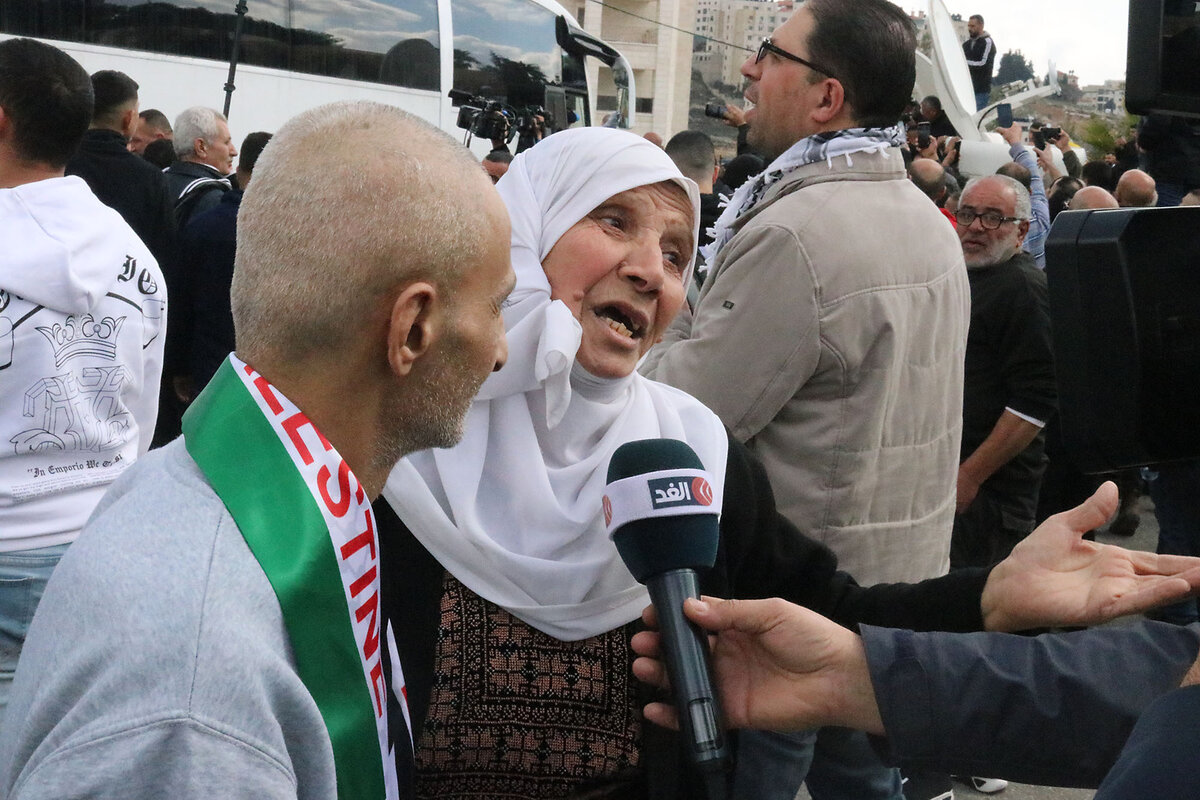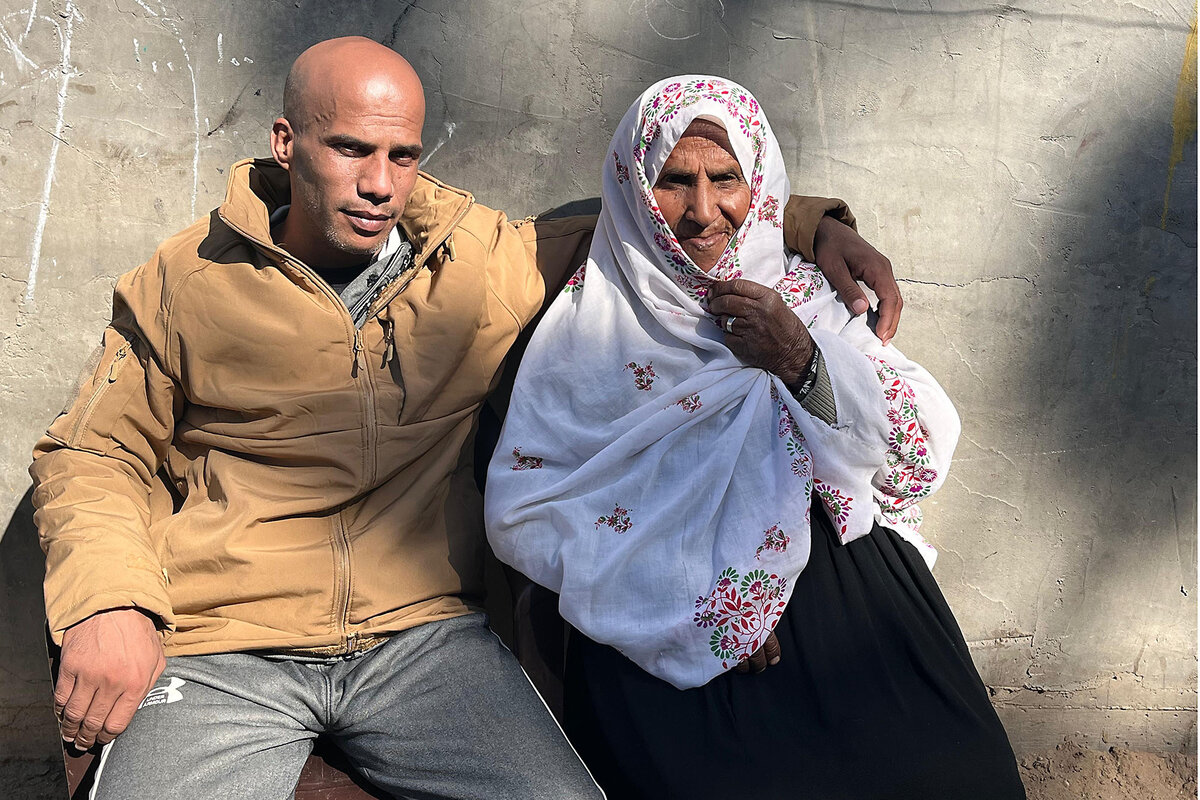As Palestinian prisoners return home, there is joy, but sorrow, too
Loading...
| Ramallah, West Bank; and Deir al-Balah, Gaza Strip
The waiting crowd cheered the bus’s arrival, buzzing like fans seeking a glimpse of a rock star.
Israel’s release of Palestinian prisoners into the West Bank and Gaza Saturday – part of the ceasefire and hostage release deal with Hamas – provided a day of good news for a people worn down by war.
For a moment in the West Bank, a region hounded by settler attacks and choked by Israeli military checkpoints, there was a rare sense of joy.
Why We Wrote This
A story focused onJoyful family reunions that the ceasefire has enabled in Israel are being echoed in the West Bank and Gaza. But few freed Palestinian prisoners, many of whom were jailed for decades, knew much of the war in Gaza, or its staggering costs.
The hundreds who had gathered at Ramallah’s Cultural Palace thronged the arriving bus. Inside were 33 prisoners, many of whom had been arrested by Israel for their activities during the second intifada more than two decades ago. Several were convicted of killing Israeli soldiers.
As the gaunt, gray-jumpsuit-wearing prisoners stepped out of the bus, they were hoisted into the air one by one, carried on the crowd’s shoulders.
Then came the tearful reunions, echoing the emotional scenes enveloping recently freed Israeli hostages: released Palestinian fathers embracing 20-something children they last saw as infants, mothers embracing freed sons they thought they would never see again.
After Wael Samara was paraded by well-wishers, his 73-year-old mother, Fatima Shawamreh, hugged him, kissed his cheek, and said softly in his ear, “Thank God you have returned, my son.”
“It’s a joy that reaches the sky,” says Ms. Shawamreh, who had not seen her son since he was jailed 23 years ago. “It’s a joy not just for our family, but the entire nation.”
Many of those released had spent more than half their lives in Israeli prisons.
“Every single one of us is born again today,” Mr. Samara says of his fellow freed prisoners. “From this very moment, I am reborn.”
“This joy is massive; there is no way mere words can describe it,” says Mohamed al-Kadroumi, who spent 22 of his 42 years in Israeli prisons, as his cousin lifts him on his shoulders.
“We had no idea” about war
The reception in Ramallah resembled a festival: Children waved Palestinian flags and the yellow flag of the ruling Fatah faction; vendors hawked fresh coffee, biscuits, and tamarind juice.
Freed prisoners and relatives helped themselves to boxes of dates and carafes of coffee laid out by the governing Palestinian Authority.
Saturday’s prisoners-for-hostages exchange, the fourth since the Israel-Hamas deal was reached in January, saw 183 prisoners released into the West Bank and Gaza. As per previous releases, a dozen Palestinians serving life sentences for killing Israeli civilians were exiled to Egypt.
Overall in this first six-week phase of the ceasefire, Israel is to release 1,900 Palestinian prisoners and detainees while Hamas releases 33 Israeli hostages – women, children, older people, and those who are sick – not all of them alive.
Many released prisoners were unaware of the war in Gaza; the few who had learned of it say they had no idea of the scale of death and destruction there that preceded their release.
“We only knew a little from what was spoken in lawyers’ visits,” says Mr. Kadroumi, moments after hearing of the scale of the war. “We had no idea how bad it was.”
“The only news we heard was that there was an attack on Oct. 7, 2023,” says Salim Awadh, who spent the last 23 years in prison. The war “was a large price to pay” for freedom, he adds.
Facing Gaza’s reality
Less joyful were the bittersweet family reunions in Gaza, where released prisoners returned to demolished homes, suddenly mourning relatives who they had no idea had been killed.
Many of those released had been working in Israel and detained without charge in the days following Hamas’ attack. Others were detained by Israeli forces in Gaza and held without charges or due process. Prisoners from Gaza spent the entire war with little or no contact with the outside world.
Ahmed Wael Dababash, arrested by Israel in the early days of the war, was informed Saturday by his father – live, on air – that his wife and daughter had been killed in an Israeli airstrike while he was in prison.
“Were they really martyred?” he shrieked as he fell to his knees. “My God!”
In Deir al-Balah, Bilal Aledini sits next to his mother, looking at the surrounding destruction one week after his release by Israel ended his 25 years in prison. A Palestinian flag stands on the outer wall of his bombed-out home.
Appearing to reach for a sense of freedom, he remains shackled to the ordeal of his prison past, describing torture, beatings, and the denial of medical care. “I want the world to know our stories,” Mr. Aledini says.
Picking up the pieces
According to Amin Shoman, director of the semigovernmental Palestinian High Commission for Prisoners and Ex-Detainees Affairs, it takes released prisoners roughly “one year of rehabilitation” to rebuild their lives and reenter society.
The number of Palestinians in Israeli jails has nearly doubled since the war began, according to the Israel-based HaMoked Center for the Defense of the Individual.
The influx has led to overcrowded cells and outbreaks of disease, according to the Israeli rights group B’Tselem, which issued a report in August 2024 accusing Israel of a “systematic, institutional policy focused on the continual abuse and torture of all Palestinian prisoners held by Israel” since Hamas’ deadly attack.
Palestinian officials say the average prisoner has lost 40 to 50 pounds of body weight; many of the prisoners freed Saturday struggled to walk. Nine were immediately hospitalized.
In Deir al-Balah, Mr. Aledini says he was denied care as diseases spread.
“Two of my friends died from complications. One of them, Motaz Abu Sneid, was a good man,” he says. “We felt helpless watching each other suffer.”
Several released prisoners said that two decades after raising arms against the Israeli occupation, they now hope for peace.
“We wish God delivers us from this situation and that we achieve peace,” says Mr. Kadroumi, in Ramallah. “We want to live in peace and freedom.”
“My only hopes for the future are that one day we will all live in peace,” adds Mr. Samara.
Qadura Fares, president of the Palestinian Prisoners Affairs Committee, who was involved in the Qatar-brokered ceasefire talks, says Saturday “was proof that the exchange of prisoners and hostages is the only available exit ramp for [Israel and Hamas] to climb down.”
After hugging the last prisoner to exit the bus, he adds, “Prisoner-hostage releases are our only exit from these crises.”








